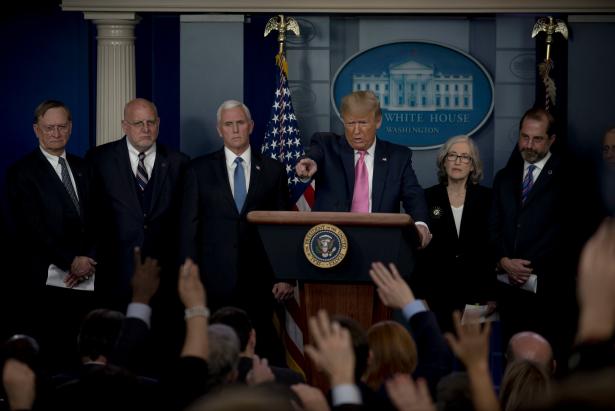So, here’s the response of the Trump team and its allies to the coronavirus, at least so far: It’s actually good for America. Also, it’s a hoax perpetrated by the news media and the Democrats. Besides, it’s no big deal, and people should buy stocks. Anyway, we’ll get it all under control under the leadership of a man who doesn’t believe in science.
From the day Donald Trump was elected, some of us worried how his administration would deal with a crisis not of its own making. Remarkably, we’ve gone three years without finding out: Until now, every serious problem facing the Trump administration, from trade wars to confrontation with Iran, has been self-created. But the coronavirus is looking as if it might be the test we’ve been fearing.
And the results aren’t looking good.
The story of the Trump pandemic response actually began several years ago. Almost as soon as he took office, Trump began cutting funding for the Centers for Disease Control and Prevention, leading in turn to an 80 percent cut in the resources the agency devotes to global disease outbreaks. Trump also shut down the entire global-health-security unit of the National Security Council.
Experts warned that these moves were exposing America to severe risks. “We’ll leave the field open to microbes,” declared Tom Frieden, a much-admired former head of the C.D.C., more than two years ago. But the Trump administration has a preconceived notion about where national security threats come from — basically, scary brown people — and is hostile to science in general. So we entered the current crisis in an already weakened condition.
And the microbes came.
The first reaction of the Trumpers was to see the coronavirus as a Chinese problem — and to see whatever is bad for China as being good for us. Wilbur Ross, the commerce secretary, cheered it on as a development that would “accelerate the return of jobs to North America.”
The story changed once it became clear that the virus was spreading well beyond China. At that point it became a hoax perpetrated by the news media. Rush Limbaugh weighed in: “It looks like the coronavirus is being weaponized as yet another element to bring down Donald Trump. Now, I want to tell you the truth about the coronavirus. … The coronavirus is the common cold, folks.”
Limbaugh was, you may not be surprised to hear, projecting. Back in 2014 right-wing politicians and media did indeed try to politically weaponize a disease outbreak, the Ebola virus, with Trump himself responsible for more than 100 tweets denouncing the Obama administration’s response (which was actually competent and effective).
And in case you’re wondering, no, the coronavirus isn’t like the common cold. In fact, early indications are that the virus may be as lethal as the 1918 Spanish Flu, which killed as many as 50 million people.
Financial markets evidently don’t agree that the virus is a hoax; by Thursday afternoon the Dow was off more than 3,000 points since last week. Falling markets appear to worry the administration more than the prospect of, you know, people dying. So Larry Kudlow, the administration’s top economist, made a point of declaring that the virus was “contained” — contradicting the C.D.C. — and suggested that Americans buy stocks. The market continued to drop.
At that point the administration appears to have finally realized that it might need to do something beyond insisting that things were great. But according to The Washington Post’s Greg Sargent and Paul Waldman, it initially proposed paying for a virus response by cutting aid to the poor — specifically, low-income heating subsidies. Cruelty in all things.
On Wednesday Trump held a news conference on the virus, much of it devoted to incoherent jabs at Democrats and the media. He did, however, announce the leader of the government response to the threat. Instead of putting a health care professional in charge, however, he handed the job to Vice President Mike Pence, who has an interesting relationship with both health policy and science.
Early in his political career, Pence staked out a distinctive position on public health, declaring that smoking doesn’t kill people. He has also repeatedly insisted that evolution is just a theory. As governor of Indiana, he blocked a needle exchange program that could have prevented a significant H.I.V. outbreak, calling for prayer instead.
And now, according to The Times, government scientists will need to get Pence’s approval before making public statements about the coronavirus.
So the Trumpian response to crisis is completely self-centered, entirely focused on making Trump look good rather than protecting America. If the facts don’t make Trump look good, he and his allies attack the messengers, blaming the news media and the Democrats — while trying to prevent scientists from keeping us informed. And in choosing people to deal with a real crisis, Trump prizes loyalty rather than competence.
Maybe Trump — and America — will be lucky, and this won’t be as bad as it might be. But anyone feeling confident right now isn’t paying attention.
Follow The New York Times Opinion section on Facebook, Twitter (@NYTopinion) and Instagram.
Paul Krugman joined The New York Times in 1999 as an Op-Ed columnist. He is distinguished professor in the Graduate Center Economics Ph.D. program and distinguished scholar at the Luxembourg Income Study Center at the City University of New York. In addition, he is professor emeritus of Princeton University’s Woodrow Wilson School.


Spread the word